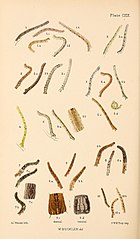| Rosy wave | |
|---|---|
 | |
| Scientific classification | |
| Domain: | Eukaryota |
| Kingdom: | Animalia |
| Phylum: | Arthropoda |
| Class: | Insecta |
| Order: | Lepidoptera |
| Family: | Geometridae |
| Genus: | Scopula |
| Species: | S. emutaria |
| Binomial name | |
| Scopula emutaria | |
| Synonyms | |
| |
Scopula emutaria, the rosy wave, is a species of moth in the family Geometridae. It is found in western and south-western Europe and Romania. Also in North Africa. [3]
Contents
The wingspan is 23–26 millimetres (0.91–1.02 in) (sometimes 20–24 millimetres (0.79–0.94 in)). Easy to distinguish by its whitish ground-colour, slight or rather strong pink flush. Most striking is the straight broad line over the wing towards the wing tip. [4] [5]
Adults are on wing from June to July. [6]

It is a coastal species. The larvae feed on sea beet and Armeria maritima . [7]